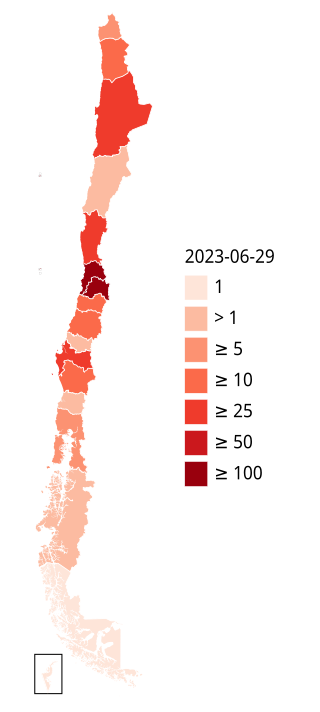
Mpox is an infectious viral disease that can occur in humans and other animals. Symptoms include a rash that forms blisters and then crusts over, fever, and swollen lymph nodes. The illness is usually mild and most of those infected will recover within a few weeks without treatment. The time from exposure to onset of symptoms ranges from five to twenty-one days and symptoms typically last from two to four weeks. Cases may be severe, especially in children, pregnant women or people with suppressed immune systems.
Orthopoxvirus is a genus of viruses in the family Poxviridae and subfamily Chordopoxvirinae. Vertebrates, including mammals and humans, and arthropods serve as natural hosts. There are 12 species in this genus. Diseases associated with this genus include smallpox, cowpox, horsepox, camelpox, and mpox. The most widely known member of the genus is Variola virus, which causes smallpox. It was eradicated globally by 1977, through the use of Vaccinia virus as a vaccine. The most recently described species is the Alaskapox virus, first isolated in 2015.
Seoul orthohantavirus (SEOV) is a member of the genus Orthohantavirus of rodent-borne viruses, and is one of the four hantaviruses that are known to cause Hantavirus hemorrhagic fever with renal syndrome (HFRS). It is an Old World hantavirus; a negative sense, single-stranded, tri-segmented RNA virus.

The monkeypox virus, is a species of double-stranded DNA virus that causes mpox disease in humans and other mammals. The monkeypox virus is a zoonotic virus belonging to the orthopoxvirus genus, making it closely related to the variola, cowpox, and vaccinia viruses. MPV is oval-shaped with a lipoprotein outer membrane. The genome is approximately 190 kb.

In May 2022, the World Health Organization (WHO) made an emergency announcement of the existence of a multi-country outbreak of mpox, a viral disease then commonly known as "monkeypox". The initial cluster of cases was found in the United Kingdom, where the first case was detected in London on 6 May 2022 in a patient with a recent travel history from Nigeria. On 16 May, the UK Health Security Agency (UKHSA) confirmed four new cases with no link to travel to a country where mpox is endemic. Subsequently, cases have been reported from many countries and regions. The outbreak marked the first time mpox had spread widely outside Central and West Africa. There is evidence that the disease had been circulating and evolving in human hosts over a number of years prior to the outbreak. The outbreak was of the Clade IIb variant of the virus.

The 2022–2023 mpox outbreak in the United Kingdom is part of the larger outbreak of human mpox caused by the West African clade (type) of the monkeypox virus. The United Kingdom was the first country, outside of the endemic African areas, to experience an outbreak. As of 22 July 2022, there were 2,208 confirmed cases in the United Kingdom, with 2,115 in England, 54 in Scotland, 24 in Wales, and 15 in Northern Ireland.

The 2022–2023 mpox outbreak in the United States is part of the larger outbreak of human mpox caused by the West African clade of the monkeypox virus. The United States was the fourth country outside of the African countries with endemic mpox, to experience an outbreak in 2022. The first case was documented in Boston, Massachusetts, on May 17, 2022. As of August 22, mpox has spread to all 50 states in the United States, as well as Washington, D.C., and Puerto Rico. The United States has the highest number of mpox cases in the world. California has the highest number of mpox cases in the United States.

The 2022–2023 mpox outbreak in Canada is a part of the outbreak of human mpox caused by the West African clade of the monkeypox virus. The outbreak started in Canada on May 19, 2022, with the country since then becoming one of the most affected in the Americas.
The 2022–2023 mpox outbreak in Portugal is part of the larger outbreak of human mpox caused by the West African clade of the monkeypox virus. Portugal was the third country, outside of the African countries with endemic mpox, to experience an outbreak in 2022.
The 2022–2023 mpox outbreak in Italy is part of the larger outbreak of human mpox caused by the West African clade of the monkeypox virus. Italy was the sixth country, outside of the African countries with endemic mpox, to experience an outbreak in 2022. The first case was documented in Rome, Italy, on May 19, 2022. As of August 5th, Italy has 505 cases.
The 2022 – 2023 mpox outbreak in France is part of the larger outbreak of human mpox caused by the West African clade of the monkeypox virus. France had its first case on 20 May 2022.
The 2022–2023 mpox outbreak in Belgium is part of the larger outbreak of human mpox caused by the West African clade of the monkeypox virus. Belgium was the fifth country, outside of the African countries with endemic mpox, to experience an outbreak in 2022. The first case was documented in Antwerp, Belgium, on 19 May 2022. As of 10 August, Belgium has 546 cases and 1 suspected case.
The 2022–2023 mpox outbreak in Australia is a part of the outbreak of human mpox caused by the West African clade of the monkeypox virus. The outbreak reached Australia on 20 May 2022. By 28 October 2022 there were over 140 confirmed cases. The Chief Medical Officer of Australia stood down the country's Communicable Disease Incident of National Significance declaration on 25 November 2022.
The 2022–2023 mpox outbreak in Israel is a part of the ongoing outbreak of human mpox caused by the West African clade of the monkeypox virus. The outbreak was first reported in Israel on 20 May 2022 when the Health Ministry announced a suspected case which was confirmed on 21 May 2022. One month later, on 21 June, the first locally transmitted case was reported.
The 2022–2023 mpox outbreak in Switzerland is a part of the outbreak of human mpox caused by the West African clade of the monkeypox virus. The outbreak started in Switzerland on 19 May 2022, with the country since then becoming one of the most affected in Europe.

In 1964 there was an outbreak of monkeypox at Rotterdam Zoo, where two Central/South American giant anteaters were first identified with the disease. Until then, monkeypox was thought to occur only in primates. Housed in one large enclosure, the monkeypox virus subsequently spread to several orangutans, chimpanzees, gorillas, guenons, squirrel monkeys, macaques, marmosets and gibbons.

The 2022–2023 mpox outbreak in Brazil is a part of the ongoing outbreak of human mpox caused by the West African clade of the monkeypox virus. The outbreak was first reported in Brazil on 9 June 2022 when a man in São Paulo was registered as the country's index case.

The 2022–2023 mpox outbreak in India is a part of the ongoing outbreak of human mpox caused by the West African clade of the monkeypox virus. The outbreak was first reported in India on 14 July 2022 when Kerala's State Health Minister Veena George announced a suspected imported case which was confirmed hours later by the NIV. India was the tenth country to report a mpox case in Asia and the first in South Asia. Currently, India has reported 23 cases of mpox.

The 2022–2023 mpox outbreak in Chile is a part of the outbreak of human mpox caused by the West African clade of the monkeypox virus. The outbreak reached Chile on 17 June 2022.
The 2022-2023 mpox outbreak in the Republic of Ireland is part of the larger ongoing global outbreak of human mpox caused by Clade II of the monkeypox virus. The first case in the Republic was confirmed on 27 May 2022.











